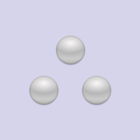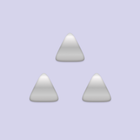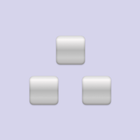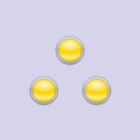Results from a number of recent journal articles suggest that silver ions, rather than the zero valent silver nanoparticles are the primary source of toxicity that has been attributed to silver nanoparticles. The release rate of silver ions from a suspension of silver nanoparticles is dependent on the surface area of the nanoparticles, the temperature, water oxygen content, and the presence and identify of surface bound ligands on the nanoparticle surface. The lifetime of free silver ions in solution also depends on the suspension environment with light exposure and salt concentration being important variables. Due to the linear relationship between the surface area to volume ratio for a fixed concentration of silver nanoparticles, smaller nanoparticles will have a higher release potential (see table below). Also, smaller nanoparticles have a higher rate of curvature and are more likely to release a silver molecule from the surface. This effect of smaller particles dissolving at a higher rate than larger particles is referred to as Ostwald ripening and is an important effect for nanoparticles with diameters less than 10 nm.
Surface area, volume, and ratio of surface area to volume of nanospheres of varying diameter
| Nanosphere Diameter (nm) | Surface area (nm2) | Volume (nm3) | Ratio Surface Area to Volume |
|---|---|---|---|
| 2 | 13 | 4 | 3.0 |
| 5 | 79 | 65 | 1.2 |
| 10 | 310 | 520 | 0.6 |
| 20 | 1,300 | 4,200 | 0.3 |
| 50 | 7,900 | 65,000 | 0.12 |
| 100 | 31,000 | 520,000 | 0.06 |
| 200 | 130,000 | 4,200,000 | 0.03 |
The concentration of silver ions in solution is determined after removing the silver nanoparticles. To isolate the nanoparticles, we recommend using either a centriprep centrifuge filter or high speed centrifuge to pellet the nanoparticles, followed by Inductively Coupled Plasma Mass Spectrometry (ICP-MS) to determine the silver ion concentration of the supernatant solution. The following table includes suggestions for centrifugation speeds and durations that will efficiently separate the supernatant from the nanoparticle pellet in our standard NanoXact and BioPure products.
The ICP-MS can also be used to measure the total silver concentration in a silver nanoparticle suspension. The nanoparticles are digested in a hot acid under pressure and then analyzed with the ICP-MS.
Centrifugation speeds to separate silver NanoXact and BioPure solutions
| Nanosphere Diameter (nm) | Centrifugation Speed (rcf) | Duration (min) |
|---|---|---|
| 10 | 40,000 | 120 |
| 20 | 25,000 | 90 |
| 30 | 20,000 | 60 |
| 40 | 16,000 | 45 |
| 50 | 15,000 | 30 |
| 60 | 14,000 | 30 |
| 80 | 12,000 | 30 |
| 100 | 9,000 | 30 |



